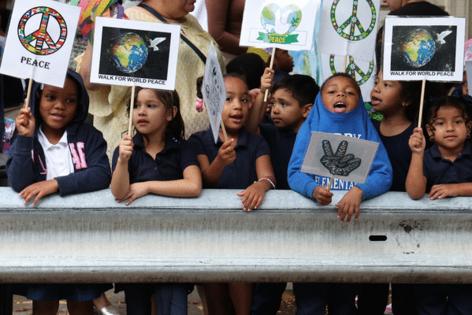New study on Illinois' public education system sees promise and problems
Published in News & Features
CHICAGO — Education in Illinois shows promising areas of growth — including improved kindergarten readiness and increased graduation rates — but remains hampered by stagnant reading and math literacy, as well as rising higher education costs, according to a new report.
Other problems plague the state as well, including chronic absenteeism and student mental health issues, which continue to be pervasive post-pandemic, according to the biennial analysis by Advance Illinois, a bipartisan education and advocacy organization. The report, released Wednesday, offers an in-depth look at the state’s education infrastructure and how public school students are faring.
Obstacles to schooling begin even before a child’s education journey, and persist after high school, due to increasing costs, according to the report.
“The bad news is there are very serious gaps, and those gaps by income, by race, by learning style, by language, have emerged even before students get to kindergarten,” said Robin Steans, president of Advance Illinois. The good news, Steans said, is that classroom rigor, persistence and graduation rates continue to increase. “Those are all moving in the right direction,” she said.
Overall, Illinois outpaces the nation in academic growth, Steans said, but there is still work to be done to ensure that all students reach their full potential, Steans wrote in the report.
The report comes amid intense federal pressures on the nation’s public education system. President Donald Trump’s administration has moved to dismantle the U.S. Department of Education, cut K-12 funding and expand school choice, in an effort to scale back the federal government’s role in education. Meanwhile, test scores from the Nation’s Report Card last month showed that students’ math and reading scores have hit new lows in recent decades.
To be sure, the most recent Illinois Report Card from last October showed growth across key indicators for success, including graduation rates, chronic absenteeism and student performance on literacy exams. State lawmakers lauded the results as a sign of an educational rebound following the COVID-19 pandemic.
The Advance Illinois report paints a more nuanced picture. “We’ve got some real work to do,” Steans said.
Kindergarten readiness improves for some groups
More children in Illinois overall are demonstrating readiness for kindergarten compared to previous years, however some student demographic groups are continuing to see gaps in readiness levels, the report states.
In 2019, 23.6% of students demonstrated readiness for kindergarten, indicating that they exhibited behaviors and skills within the expected range for children in social-emotional development, language and literacy, and mathematics. That number rose over the last five years to 31.6% in 2024.
However, the path to kindergarten readiness widened for some groups, including English Learners, by family income, and by disability status, from 2018 to 2023. The English learner gap is “shocking,” Steans said. “Those gaps, by income, by race, by learning style and by language have emerged even before students get to kindergarten,” Steans told reporters during a news conference.
Additionally, more Illinois children overall are demonstrating levels of proficiency in language and literacy, math and social and emotional development. Kindergarten readiness is a strong predictor of future academic success in school. And while Illinois students are improving on this front, only a third are demonstrating readiness in language and literacy, math and social-emotional development, so “it’s sure not where we want it to be,” Steans said.
Even so, kindergarten readiness is a strong indicator of future success, Steans said.
Postsecondary attainment
More Illinois students are attaining higher education degrees, the report said, but Black and Latino students are significantly less likely to graduate.
Community college retention in Illinois ranks among the top five states in the country, while four-year, public university retention is middle-of-the-pack. Socioeconomic diversity has also grown at postsecondary institutions.
“The number of adults in Illinois who have earned a credential, associate’s degree or four-year degree continues to improve,” Steans said. “That has been on a steady increase … and that is also true across every demographic.”
Still, at public universities, about 59% of Black students and 75% of Latino students earn a degree, compared to the statewide average of 80%. Graduation rates have inched up overall in the past decade, but only nominally.
Anecdotally, students cite a range of obstacles to earning a degree — from soaring costs to complex application processes. Despite those barriers, a recent report from the Illinois State Board of Education showed that higher education remains the strongest pathway to economic mobility.
Illinois families struggling to afford college, child care costs
Notably, state spending on higher education is among the lowest in the country, the report said. The lack of state investment means greater costs are transferred on to students and parents.
“The lower the state investment goes, the higher the tuition goes,” Steans said. “As we have started putting in more money in the last few years, you’ve started to see tuition start to stabilize, but it’s still way too high.”
For a household at the poverty line, tuition and fees for a four-year public university account for 51% of household income. The net price, which accounts for state financial aid and scholarships, still comes out to 31% of income. Black and Latino families are disproportionately impacted, highlighting the need for increased investment, the report said.
Child care in Illinois is also marked by high costs. The cost of center-based toddler care has increased by $800 from 2018 to 2022. Home-based care costs have grown even more — up $4,000 in the same period.
“The costs of child care at the early birth to three, in particular, are problematic,” Steans said.
Student well-being continues to decline
Students are reporting worsening levels of wellness and mental health, an additional cause for concern for districts and schools across the state.
According to the report, 77% of Illinois youth have undergone an adverse childhood experience, or an ACE, which is a potentially traumatic event in childhood like experiencing or witnessing violence, abuse, or neglect. Additionally, Black students are over twice as likely to have reported three or more ACE events than the statewide average.
In Illinois high schools specifically, 26% of students reported that their mental health was most of the time or always not good. The percentage of Illinois students feeling sad or hopeless increased significantly from 27.8% in 2009 to 38.2% in 2023. Female students feel the effects more, with those students reporting feeling hopeless at a rate 28.1 percentage points higher than male students, the report states.
Additionally, the percentage of students who seriously considered attempting suicide also saw a rise, increasing from 14.5% in 2009 to 19.2% in 2023. Chronic absenteeism has coincided with the changes, increasing across all student groups statewide from 18% in 2019 to 26% in 2024. The Chicago Public Schools district had a chronic absenteeism rate of 40.8% across the district in 2024, according to the Illinois Report Card.
These are historic and worrisome levels for both student well-being and chronic absenteeism, which Steans said are predictors of later academic success.
“Every indication of student wellness is bad and getting worse,” Steans said. “…These realities are driving tons of outcomes and are going to continue to show up in outcomes.”
When it comes to higher education, twice as many students reported feeling that their mental health affected their academics compared to 2007. These rates were especially higher among certain student groups, including Latinx, those with disabilities, those with higher financial stress, trans students, and students who identify as LGBQ+, according to the report.
This trauma and lack of student wellness can have adverse effects on academic success, the report states. However, an increase of state funding through the evidence-based funding (EBF) model has led to the hiring of more student support personnel like school psychologists, counselors, and social workers, Steans said.
Still, more needs to be done, she said, adding that only 13% of students in the state attend schools that have the recommended level of counseling.
“Tons of progress, fueled by EBF, but still not where we need to be,” Steans said. “And there are gaps in who’s got access to social workers and counselors, including by race.”
____
©2025 Chicago Tribune. Visit at chicagotribune.com. Distributed by Tribune Content Agency, LLC.







Comments